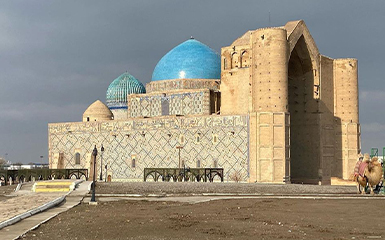Aisha-Bibi mausoleum
Aksu-Zhabagly
Aktau
Almaty
Altyn-Emel
Arystan Bab
Atyrau
Azret Sultan
Babaji Khatun
Bayanaul
Begazy necropolis
Beket-Ata Mosque
Almaty Lake
Lake Burabay
shakpak-ata-cave
Charyn Canyon
Hilvet mosque
Hodja Ahmad Yesevi
Holy Cave
Kaindy
Kapchagay
Karakhan mausoleum
Karkaraly
Kizhel Kensh
Kolsai Lakes
Korgalzhyn
Balkash lake
Lake Shaitankol
Jochi Khan
Karasai and Agyntai Batyr
Kozy Korpesh and Bayan Sulu
Mashkhur Zhussip Kopeyuly
Rabiga Sultan Begim
Kenty-Baba
Nomad Fortress
Nur-Sultan
Ruins of Otrar
Ruins of Sauran
Shopan-Ata
Shymbulak
Sultan-Epe
Tamgaly Gorge
Tamgaly-Tas
Alasha Khan
Torysh
Zhirensakal Peak
The tomb of Hodja Ahmed Yesevi was built in the name of the Mongolian ruler Timur between 1389-1405 in the city of Yasi (now the city of Turkestan in Kazakhstan). Although partially unfinished, it is one of the largest and best preserved structures from the Timurid period. At Yesevi's mausoleum, he experimented with construction technology and the art of decoration, which would later shine in his capital, Samarkand.
Hodja Ahmed Yesevi (also Ahmet Yesevi; 1103-1165) is an important representative of Sufism (Islamic Sufism), a branch of Islam prevalent in Central Asia. The collection of manuscripts was declared World Document Heritage in 2003 and is now in the National Library of the Republic of Kazakhstan.
Kazakh Khan of the Middle Horde Ablai was buried in the mausoleum in 1781.
The tomb has been on the UNESCO World Heritage List since 2003.
In 1396, Aksak Temir, the ruler of Central Asia, ordered that a new tomb be built in place of the old tomb of Hodja-Ahmed Yesevi. It fell many times during the construction of the mausoleum. Then, in the dream of the Great Sovereign, an elder gave a vision and said, "Hodja-Akhmet had a teacher named Arystan. So first build a tomb for Arystan and then for his disciple."
Let us go back to the conversation above. Emir Temir brought bricks from Turkistan and had a large domed tomb built for Arystanbab. Only then, the tomb dedicated to Hodja-Akhmet was not destroyed and the life of the ruler progressed.
The tomb of Hodja Ahmed Yesevi is a domed structure with a large portal. It is 46.5 m wide and 65 m long. The building has a large portal (width - about 50 meters, the length of the portal arch - 18.2 m) and several domes. There are 35 rooms for different purposes around the central hall. The height of the building from the top of the dome of the church (here it is called the boiler due to the location of the boiler) is 37.5 meters. The thickness of the outer walls is 1.8-2 m; the thickness of the boiler walls is 3 meters.
This high-rise building, whose general structure is symmetrical, and whose individual sections are asymmetrical, consists of eight different room groups: Kazan, Great White House, Little Aksaray, Well, Library, Dining, Enterprise and Mosque.


